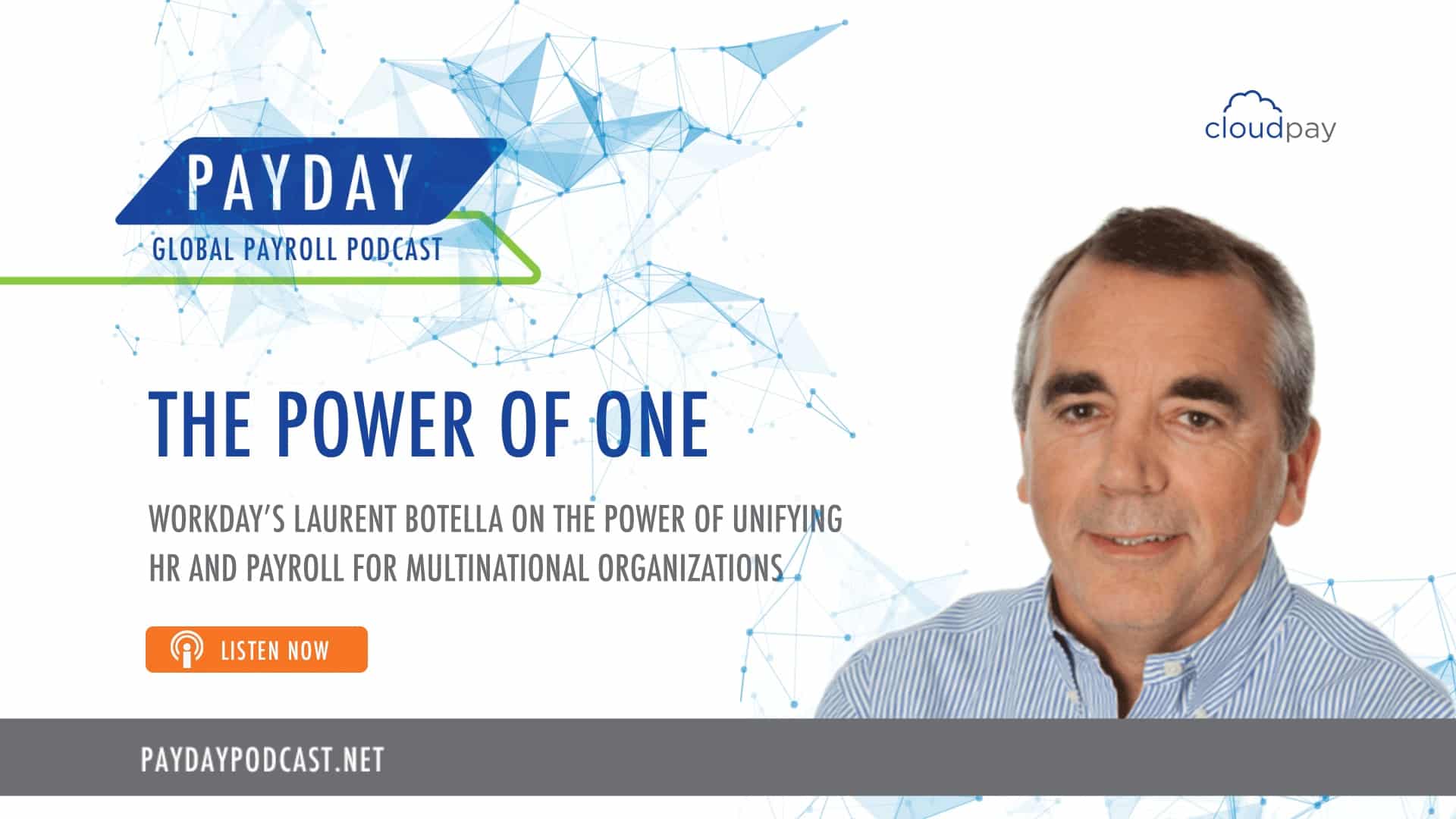Payroll often represents the most significant portion of an organization’s annual revenue spend, though many leaders rarely consider payroll outside of the need to get employees paid. In reality, payroll is much more than a payslip. It can be one of the most complex aspects of running a business due to the needs of managing tax compliance, reporting, and administration.
That complexity of payroll only increases with each new country a company expands into. The necessity to pay workers in different countries isn’t new—that’s been a requirement since businesses began expanding to foreign markets. However, in today’s globalized economy, the ability to pay workers around the globe is an everyday requirement rather than a unique or one-time need. That’s why more multinational organizations manage their payroll function via an optimized international payroll solution.
Conflicting regulations, data restrictions, benefits discrepancies, and other challenges increase when companies must consider the needs of multiple international and domestic locations. There are a variety of ways to process compensation and provide it to employees on a schedule, including payroll outsourcing. Most organizations have moved beyond trying to manage foreign payroll with outdated systems.
Technology and cloud-based platforms are expanding and elevating the payroll function beyond getting people paid. Yet the details of managing multi-country payroll can vary significantly across providers. Today’s top payroll platforms have made the foreign payroll process more efficient and relevant, and in turn, are empowering organizations in powerful ways.
Equipped with efficient platforms that provides relevant data and insights, payroll leaders are entering an era in which they are empowered to support organizations in making strategic decisions around this fundamental part of the business.
- Read more about The Strategic Importance of Payroll
- Listen to a podcast about Emerging Trends in Global Payroll
- Discover the COO predictions for 2025
Elevate performance with integration
To understand how payroll leaders are now more empowered, let’s look at the previous model for delivering payroll services for foreign employees. In the past, vendors relied on an “aggregator” method, in which one global service provider would partner with a multitude of local payroll providers to process a customer’s payroll in various each foreign country. That global service provider would then aggregate the payroll data into one application.
In this model, the data appears robust. But under the surface, the processing is done differently across disparate systems, which makes it impossible to guarantee data consistency. Similarly this method prohibits the payroll team from controlling the processing of their data, which means they cannot count on a standardized process or reliable results. This aggregator method creates a lack of data consistency and integrity, which is problematic at best.
“Fragmented systems lead to duplicate information and repetitive entries as employees working with different data sets attempt to collaborate,” as noted in the Inc. article Fragmented Software Is Killing Business Productivity. “If users don’t ensure that they’re working off the most up-to-date version, errors and overlap occur. Similarly, some businesses use different software solutions for different areas of operation, leading to disjointed processes and lost productivity.”
Today’s advanced multi-country payroll solutions address these issues of fragmented data. Rather than cobbled-together data from numerous local providers, a centralized platform in the cloud enables accurate, standardized processing in real time. A unified international payroll platform uses one application and one source of data for all locations worldwide. One platform makes it easy to maintain a single, truly integrated source of data for all domestic and overseas employees.
- Read why Not All Payroll Solutions Are Created Equally
- Listen to a podcast on HR Transformation and its Effects on Payroll
- Discover the 5 Most Common Payroll Challenges
Establish a single source of truth (SSoT)
When information is fragmented, it also becomes challenging to establish a single source of truth for data and results that can guide decisions throughout the organization. Making decisions on unreliable data can cause confusion and loss of productivity, and ultimately hurt the bottom line. Some providers may claim that their data is integrated, but few empower their customers with real-time insights into processes and outcomes.
The terms “centralized” and “standardized” are often used but don’t mean the same thing for every provider. With an integrated model for multi-country payroll, both the provider and the business have access to a comprehensive, complete, standardized record of information, which they can access via self-service regardless of their location. Centralized data means information exists as a single dataset, often referred to as a Single Source of Truth (SSoT). Establishing a SSoT requires one platform that processes payroll across all locations.
Cloud technology now enables global organizations to use one payroll processing platform for all domestic and international employees. There are immediate benefits when data is collected, processed, and stored within the same system because data exists natively in the same standardized format. An SSoT removes the need to maintain a master file, which saves time and improves efficiency. Similarly, the increased visibility of payroll data allows for more advanced and timely analytics. These capabilities also contribute to better regulatory compliance and boost the ability to perform audits.
- Read more about the benefits of Prioritizing Data Visibility
- Listen to why a single platform and a single source of truth are key
- Download a report on Next-Generation Payroll Analytics
Set strategy based on data-based logic
In the last twenty years, there’s been a shift from desktop to cloud, and to shared data in various business functions including HR and finance. Unfortunately, old foreign payroll models persist, which means sophisticated, standardized HCM and finance data is transferred into a fragmented payroll system. As a result, human resources and finance are able to deliver insights, while payroll exists merely to process pay.
In the current data-driven environment, companies at the forefront understand the relevance of payroll data, particularly when it comes to human capital management and the employee experience. To elevate the function, outdated multi-country payroll needs to move to the cloud, too. This shift can help enterprises access standardized payroll data which they can then analyze and apply to critical strategic needs, such as talent planning and workforce retention.
Payroll is responsible for the largest source of company-specific data that is continually updated, but most companies don’t use that data. To get the most from this important source, it’s essential that payroll data is accurate as well as accessible, so payroll operations can glean the strategic insights that influence and impact the business. Cloud-based international payroll solutions paired with a sophisticated HR system enables shared single-source data to align workflows and reduced processing times on both sides.
- Read How Integration is Shaping the Future of Payroll
- Listen to a discussion on the convergence of fintech, HR and payroll
- Download a report about Robotic Process Automation in Payroll
Identify value and long-term impact
Aggregator international payroll models may meet the basic need of getting people paid, but these outdated systems create other costs. Such models limit an organization’s ability to access data that enables strategic insights. With fragmented payroll systems, the ability to develop data-driven, long-term strategies diminishes significantly.
At a minimum, centralized multi-country payroll enables improved accuracy and timely processing by reducing hidden costs and the opportunity for errors. With the time saved by using an efficient platform for global payroll services, teams can address challenges and create opportunities for improvement. While paying employees properly, organizations are also mastering data protection and compliance. Moreover, they’re using their valuable payroll data to gain competitive insights and manage resources.
For companies that want the most out of their investment, modern international payroll solutions are the way forward.
- Read about The Essential Next Step in Payroll
- Listen to the value and potential of global payroll and HR data
- Download a report on Delivering Real-Time Insights from Payroll
Transition the technology
The way forward can be difficult to navigate because people tend to avoid change, particularly when it comes to an essential function like payroll. It may be easy to identify the benefits of better foreign payroll, but to gain leader buy-in, you must specify how a new payroll solution will help you meet operational and strategic goals. Change management is of critical importance when discussing changes to a core function like payroll, which leaders may be reluctant to alter.
As you start looking for a new international payroll solution, there are many factors to consider. Start by evaluating if your organization is ready for centralized global payroll services. Evaluate your current system—look for the hidden costs as well as the areas in which the current system falls short. Also, get clear about the requirements of both your domestic and your foreign payroll locations. What regulations, security, and data restrictions can a new solution help you address?
- Read about 3 Essential Questions to ask before you begin
- Listen to one well-known multinational’s journey to unified global payroll
- Discover how to Build a Successful Global Payroll RFP
Multi-country payroll is much more than a desktop system that ensures everyone gets paid. Today, international payroll provides answers and insights about how to make the most of your most important resource—your people. The information gained can be used to not only transform your approach to payroll but can also impact the entire organization’s approach to talent management.




